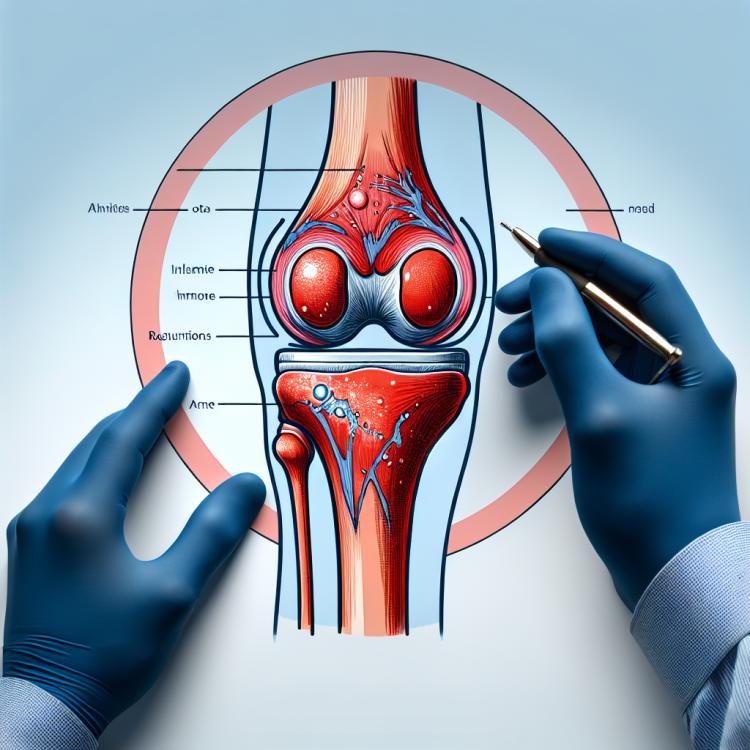
Knee joint tendinitis: symptoms, causes, and treatment
- Understanding Knee Joint Tendinitis
- Factors contributing to the development of knee joint tendinitis
- The main signs of knee joint tendinitis
- Approaches to the treatment of knee joint tendinitis, according to experts
- Methods of diagnosing knee joint tendonitis
- Methods for treating knee joint tendonitis
- Prevention of knee joint tendonitis
- Amazing aspects of knee joint tendinitis
- FAQ
Understanding Knee Joint Tendinitis
Knee tendonitis is an inflammatory condition that affects the tendons and surrounding tissues in the knee area. This condition is usually caused by excessive loads on the knee joint, frequent repetitive movements, or injuries, leading to irritation and inflammation of the tissues.
Symptoms of knee tendonitis may include pain, swelling, and restricted mobility in the knee area. Diagnosis is based on clinical manifestations, examination, and sometimes imaging, such as X-rays or MRI. It is important to identify and properly treat tendonitis early to prevent complications and restore full functionality of the knee joint.
Factors contributing to the development of knee joint tendinitis
Tendinitis of the knee joint can occur as a result of tissue damage or due to overloading the joint, which can lead to inflammation of the tendons. The risk of developing this condition increases when engaging in sports that require frequent repetitive knee movements, improper technique during exercises, and insufficient warm-up and stretching before training.
The features of the structure and functioning of the knee joint can also play a role in the onset of tendinitis. For example, anomalies in the joint structure can create uneven distribution of stress on the tendons, increasing the risk of an inflammatory reaction. Effective prevention of knee tendinitis is based on proper exercise techniques, conscious control of loads, and timely treatment of injuries and inflammation.
- Frequent repetitive movements: Repetitive movements, especially during sports exercises, can overload the joint and lead to tendon irritation.
- Lack of warm-up and stretching: Failure to follow warm-up and stretching exercises before physical activity can increase the risk of developing knee tendonitis.
- Improper exercise technique: Incorrect training techniques can unevenly load the knee joint, increasing the risk of tendon damage.
- Hereditary factors: Some anomalies in the structure of the knee joint, passed genetically, can contribute to the development of tendonitis.
- Excessive load: Excessive physical activity without necessary rest can lead to overloading the knee joint, increasing the risk of tendon inflammation.
The main signs of knee joint tendinitis
Knee joint tendonitis can manifest through various symptoms, including pain, swelling, and restricted joint mobility. Patients often complain of pain in the knee area, which worsens with movement, especially when climbing stairs or bending the leg. Swelling and redness around the knee may also be signs of tendon inflammation.
In knee joint tendonitis, a characteristic grinding sensation in the joint may sometimes occur during movement. It is important to pay attention to changes in sensations and the functionality of the knee, such as weakness or joint instability, to timely seek medical attention for the diagnosis and treatment of this condition.
- Pain: One of the main signs of knee tendonitis is pain that can be sharply localized in the knee area and worsen with movement.
- Swelling and redness: Inflammation of the tendons may be accompanied by swelling and redness in the knee area, indicating the presence of an inflammatory process.
- Limited mobility: Knee tendonitis can lead to limited mobility of the joint, especially when bending or straightening the leg.
- Creaking sensation: A characteristic creaking sensation may occur during knee movements, caused by the friction of damaged tissues.
- Weakness and instability: Joint instability and a feeling of weakness in the leg can be signs of tendonitis, indicating a disruption of the normal functionality of the knee joint.
Approaches to the treatment of knee joint tendinitis, according to experts
Experts agree that the approach to treating knee tendonitis should be individualized and based on careful diagnosis and assessment of the degree of the inflammatory process. The initial stage of treatment often involves rest and limiting physical activity to prevent further irritation of the inflamed tissues. Physiotherapy and rehabilitation play an important role in restoring the function of the knee joint after the inflammation has been resolved.
Treatment of knee tendonitis may also include the use of anti-inflammatory medications to reduce pain and swelling. In some cases, injection therapy may be required for the local administration of medications into the area of inflammation. Surgical intervention is considered in extreme cases when conservative methods do not yield the expected results.

Methods of diagnosing knee joint tendonitis
To diagnose knee joint tendonitis, a doctor may use various methods, including physical examination, discussion of the patient’s medical history, and examinations using equipment. During the physical examination, the specialist pays attention to the nature of the patient’s pain, the level of joint mobility, the presence of swelling, and other signs of inflammation.
Additional methods for diagnosing knee joint tendonitis may include X-rays, ultrasound examination, and magnetic resonance imaging (MRI). These methods help the doctor gain a more detailed understanding of the condition of the tissues and the joint, which is important for making an accurate diagnosis and determining the optimal treatment plan.
- Physical examination: The doctor performs an examination of the joint, assessing pain sensations, swelling, mobility, and other signs of inflammation.
- Patient’s medical history: Studying past injuries or illnesses helps to consider risk factors and more accurately diagnose.
- X-ray: An X-ray can help identify changes in bone tissue and the structure of the joint.
- Ultrasound examination: Allows assessment of the condition of soft tissues, tendons, and joint capsules.
- Magnetic resonance imaging (MRI): This method provides detailed images of tissues, helping to clarify the diagnosis and identify areas of inflammation.
Methods for treating knee joint tendonitis
In cases where conservative methods do not yield sufficient improvement, surgical intervention may be necessary. Surgery may be recommended to remove damaged tissues or correct structural anomalies of the joint. The postoperative period requires strict adherence to the doctor’s instructions and a professional rehabilitation process to restore the functionality of the knee joint.
- Rest: Rest and limiting load help reduce inflammation in the knee joint tendons.
- Therapeutic exercise: Special exercises aim to strengthen the muscles and tendons, improving joint mobility.
- Physiotherapy: The use of physical procedures like ultrasound and laser therapy can help reduce inflammation and alleviate pain.
- Anti-inflammatory medications: The use of pharmaceuticals can aid in reducing inflammation and pain in the knee joint.
- Surgical treatment: In cases where conservative methods prove ineffective, surgical intervention may be necessary to correct damage or anomalies in the joint.
Prevention of knee joint tendonitis
Monitoring the level of physical activity, optimizing training loads, and regularly adhering to a rest regime also play a key role in the prevention of patellar tendonitis. Attention should also be paid to nutrition, including the consumption of sufficient nutrients that promote joint and connective tissue health, to support their normal functioning and reduce the risk of inflammatory processes.
- Warm-up and stretching: Regular warm-up and stretching of muscles and tendons before physical exercises help prevent injuries and reduce the risk of inflammation of the knee joint.
- Proper exercise technique: Learning and adhering to the correct technique during sports activities helps avoid overloads and injuries to the knee joint.
- Monitoring physical activity levels: Optimal physical activity, without excessive load, contributes to joint health and the prevention of tendinitis.
- Proper nutrition: A balanced diet rich in nutrients supports joint health and reduces inflammatory responses.
- Regular rest and recovery: Properly alternating workouts with rest will help ensure normal recovery of joints and associated tissues.
Amazing aspects of knee joint tendinitis
Another surprising aspect of patellar tendinitis is its heterogeneous course and response to treatment. Some patients respond successfully to conservative methods such as physical therapy, while others may require surgical intervention. This individualization of the approach not only highlights the importance of a comprehensive treatment strategy but also reflects the unique characteristics of each case of patellar tendinitis.